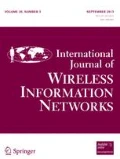Abstract
In recent years, various access technologies have been studied for wireless access to telephone networks and for personal digital radio communications. This paper discusses the performance of a slow-frequency-hopped time-division multiple access (SFH-TDMA) technique, which can be considered as a “high-tier” extension of a low-complexity TDMA architecture optimized for low-power pedestrian applications. A hard-limited receiver is employed, and a novel weighting factor for diversity combining is developed to achieve an effect similar to that of a maximal ratio combiner. Numerical performance results for frequency-selective and non-frequency-selective fading channels over a range of fading rates were obtained through computer simulations. Results indicate that, with the proposed weighting factor for diversity combining, the degradation due to receiver hard-limiting is less than 1.5 dB in a SFH-TDMA system.
References
D. Verhulst, M. Mouly, and J. Szpirglas, Slow frequency hopping multiple access for digital cellular radiotelephone,IEEE J. Selected Areas Commun., Vol. SAC-2, pp. 563–574, 1984.
M. Mouly and M. B. Pautet,The GSM System for Mobile Communications, 1992.
K. S. Gilhousen et al., On the capacity of a cellular CDMA system,IEEE Trans. VT, Vol. 40, No. 5, pp. 303–312, 1991.
Wideband spread spectrum digital cellular system dual-mode mobile station-base station compatibility standard,TIA IS-95 Interim Standard, 1993.
P. D. Rasky, G. M. Chiasson, and D. E. Borth, An experimental slow frequency-hopped personal communication system for the proposed U.S. 1850–1990 MHz band,ICUPC'93 Conference Proceedings, Oct. 12–15, 1993, Ottawa, Canada.
D. C. Cox, A radio system proposal for widespread low power tetherless communications,IEEE Trans. Commun., Vol. 39, pp. 324–335, 1991.
Bellcore document, TR-INS-001313,Generic Criteria for Version 0.1 Wireless Access Communications Systems (WACS), issue 1, October 1993.
S. Ariyavisitakul and L. F. Chang, Performance of unequalized frequency-hopped TDMA on dispersive fading channels,International Journal of Wireless Information Networks, Vol. 1, No. 2, pp. 107–115, 1994.
J. G. Proakis,Digital Communications, McGraw-Hill, New York, 1983.
S. Ariyavisitakul, Equalization of a hard-limited slowly-fading multipath signal using a phase equalizer with time-reversal structure,”IEEE J. Selected Areas Commun., Vol. 10, pp. 589–598, 1992.
W. C. Jakes, Jr., Ed.,Microwave Mobile Communications, Wiley, New York; 1974.
Author information
Authors and Affiliations
Rights and permissions
About this article
Cite this article
Chang, L.F., Ariyavisitakul, S. Performance of slow-frequency-hopped TDMA with a hard-limited receiver. Int J Wireless Inf Networks 2, 91–98 (1995). https://doi.org/10.1007/BF01464459
Issue Date:
DOI: https://doi.org/10.1007/BF01464459

